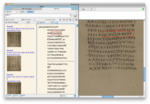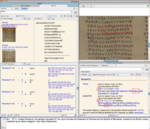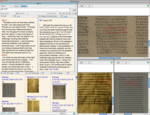At the Annual Meeting of the SBL we unveiled several new releases, but the one I am most excited about is the New Testament Manuscripts Image Collection. This is not only because I am somewhat of a self-professed Greek-geek, but also because I was able to see this project through from conception to completion. Most of the projects our team works on consist of electronic text conversions of existing print publications. In this case we were creating a totally new product.
We used the Scripture ranges provided to us (with some modification), created e-texts for the facsimile introductions, and then interleaved the high-resolution images taken by the CSNTM. The end result is the first of its kind: a fully indexed, locally stored collection of high-resolution images of four facsimiles (including one pseudo-facsimile), and one original manuscript of the Greek New Testament. In what follows, I’ll walk you through what is included in this collection, along with an example of the type of research that this enables, both for the novice and expert text-critics.
The following manuscripts are included in the collection:
- Codex Sinaiticus 01, 4th century (GNT-SI Images): 1911 facsimile edition by Kirsopp and Helen Lake, containing the complete New Testament plus the Shepherd of Hermas and Epistle of Barnabas (images not included in this collection) with introduction to the manuscript.
- Codex Alexandrinus A02, 5th century (GNT-Alex Images): 1879 facsimile edition by E. Maunde Thompson, containing the New Testament (starting at Matt 25.6) and the Clementine epistles (images not included in this collection) with introduction to the manuscript.
- Codex Vaticanus B03, 4th century (GNT-Vat Images): 1868 pseudo-facsimile edition by Caroli Barnabitae and Ioseph Basiliani, containing the New Testament. This edition was typeset by hand, and does not contain images of the actual manuscript.
- Codex Washingtonensis W032, 4-5th century (GNT-Was Images): 1912 facsimile edition by Harry Sanders, containing the four Gospels, with introduction to the manuscript.
- Codex 2882, 10th century (GNT-2882 Images): Original images of the Gospel of Luke, written in a minuscule hand, with a brief introduction to the manuscript and an additional collation of readings against the Majority Text.
Now, consider the following example from Romans 5.1 as an example of the type of research possible. (Click on these thumbnails to see the full-size image.)
The major variation unit in this verse is one of my favorites to show, because it involves a clash between extrinsic and intrinsic probability. On the one hand, the manuscript support for ἔχωμεν (let us have) is superior, but on the other it is far more likely that the Apostle meant ἔχομεν (we have). But, let’s say you want to see the manuscript data for yourself:
In the first shot you can see the text of Codex Sinaiticus in parallel with the images. Clicking on an image thumbnail displays it in a Zone – a new feature of version 9. Tip: to zoom in on a portion of an image (in any tool or map in Accordance), draw a box around the area and double-click within it. For those who can read Greek, note that the original hand of Sinaiticus wrote ἔχωμεν (let us have), but the corrector placed an omicron just above the omega.
In the second shot you see the same text and image, but this time with two additional resources opened – The CNTTS Apparatus in parallel, and Comfort’s NTTTC in a Zone tied to the text. Both of these resources list in detail the manuscript support for each reading, noting the reading of original hand (*) and the corrector (1). Tip: in Sinaiticus, to view a full-color photograph of the manuscript at the British Library’s website, simply click on the manuscript heading (Quire 82 folio 2 verso) and your browser will open to it (Firefox works best).
So, how does this variation appear in the different English versions? As you can see in the NTTTC, every English version except for the NEB adopts ἔχομεν (we have), placing the other reading in the margin.
Finally, in the last shot you see this same verse in Alexandrinus and Vaticanus. Since the other two manuscripts only contain the Gospels (Washingtonensus) or just Luke (2882) they can’t help out here. But, below is a short slideshow (Flash) from them to give you can idea of the quality of the images they contain.
Whether you’re a seasoned text-critic or just starting to learn, the NT MSS Images Collection will make a perfect addition to your Accordance library. For more info on the CSNTM and their latest expeditions, check out their website: CSNTM.org.




